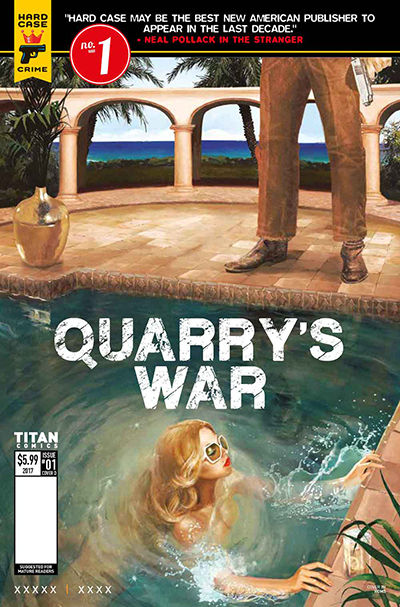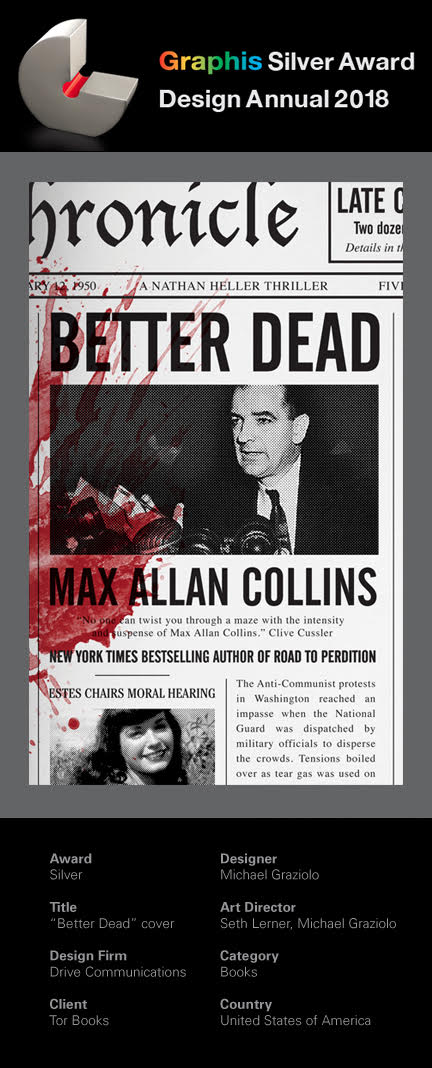
The Quarry comic book mini-series (which will later be collected as a graphic novel) was officially announced at San Diego Comic Con, where I was not in attendance. The splendid cover is included here for your enjoyment, although my enjoyment is hampered by the fact that my name isn’t on it.
I trust this is an oversight that will be rectified by Hard Case Crime Comics, though I admit it rankles when the writer of the other comic book announced did make the cover of that number one issue.
I will leave it to you whether to file this under “What am I, chopped liver?” or sour grapes.
In the meantime, here’s the Booklist advance review of Quarry’s Climax:
Oct 2017. 240 p. Hard Case Crime, paperback, $9.95. (9781785651809). e-book, (9781785651816).
Chronology is always a little tricky in Collins’ Quarry series. Take this one. It’s a new entry, but the story is set in the 1970s, when the first Quarry thrillers were written. The hit man with a heart of steel (and a skewed sense of, well, just desserts) is working for the Broker, a murder middleman who farms out hired kills to his operatives. This time it’s a little complicated: Quarry and his partner, Boyd, must first dispatch the hitters sent to eliminate the publisher of the Memphis-based porn mag, Climax; then determine who hired the hitters; and, finally, get rid of them, too. All in a few days’ work for the resourceful Quarry, of course, who developed his killing chops as a Vietnam sniper, but along the way Collins treats us to a wonderfully vivid look at the pornography industry in its heyday. From publishers to centerfolds to strippers to feminist protesters, he cuts through the stereotypes with quick bits of subtle characterization (but, please, don’t say you read a book with ‘Climax’ in the title only for the characters).
— Bill Ott
The title of this week’s update is a line from the Monkees’ “A Little Bit Me, A Little Bit You,” which Crusin’ covered for a Monkees tribute CD some years back. But the subject is not rock ‘n’ roll – rather, the now legendary tendency of my wife Barb and myself where walking out of movies is concerned.
We were walking out of so many movies, readers of this weekly update were wondering what movies I might actually be able to tolerate, or perhaps even (choke) like. But others have noticed that there have been no reports of such walk-outs lately.
One possible reason for all the walk-outs has been a spate of overblown, mediocre would-be blockbusters, frequently cribbed from comics or otherwise pop-culture retreads. The Great Wall and Kong: Skull Island are typical. CHIPs and Baywatch are the kind of movies where you consider walking out during the trailer, which is all we saw of them.
The truth is, though, something strange happened this summer, at least so far: the blockbuster movie releases have been…how can I put it…good. Here’s a rundown on them, just little mini-reviews to pop like Milk Duds. And what part of the cow is the “dud,” anyway? A few of these I’ve already commented on, in passing.
Guardians of the Galaxy Vol. 2. A lot of care went into making sure the quirky humor of the first film was maintained, and it paid off. Casting Kurt Russell was a very good move. These movies know exactly how to walk you up to sentimentality and then drop the trap door on you.
Wonder Woman. Chris Pine, channeling William Shatner in the manner of the recent Star Trek movies, contributes humanity and humor while lead Gal Gadot brings provides charm, beauty and athleticism in an epic origin tale craftily set in a vivid Great War setting. And it’s surprisingly faithful to the Golden Age comic book.
The Mummy. The weakest of the non-walkout-worthy summer blockbusters is nonetheless a lot of fun, with Tom Cruise (no matter what you may think about Scientology) bringing his genuine movie-star charisma and skill to the party. A female mummy (Sofia Boutella) is a nice twist, although too much back story and the clumsy inclusion of Jekyll/Hyde (Russell Crowe) is a lame attempt to build a franchise nobody is waiting for.
Baby Driver. A reminder of what it felt like to go to the movies in the ‘70s and early ‘80s, this is a slick, fast-moving crime film that is propelled by music and moves from one phenomenal, and mood-changing, set piece to another. It’s an outrageous melodrama, with compelling, often larger-than-life characters. Not sure the proposed sequel is a good idea, though.
Spiderman – Homecoming. It took some doing, getting Barb to go along, and she wasn’t won over immediately. But this third reboot (who’s counting?) manages to both re-imagine and yet be quite faithful to the Stan Lee/Steve Ditko original (how I wish I had hung onto Amazing Fantasy #15). Tom Holland is a winning Peter Parker/Spidey, though the heart and soul of the movie, oddly enough, belongs to the villain, the wonderfully cast Michael Keaton. Only real flaw is how hard the film works to invoke other aspects of the Marvel film franchise universe, with much more Avengers and Iron Man stuff than necessary. It’s too much salt on an already well-seasoned popcorn.
War for the Planet of the Apes. This may be the best Planet of the Apes movie of all, and as good as the two previous ones are (Rise and Dawn), that’s saying something. There is a grandeur and even majesty to this one, and the believability of the apes is complete and stunning. But it’s also emotionally wracking, action-packed and even frightening. Give Andy Serkis an Oscar already, would you, Academy?
Dunkirk. I’ve never been a Christopher Nolan fan, but I am now a convert. This is the year’s best movie so far. It’s demanding – for Americans, the various Brit accents may mean losing this line or that one, and there’s no Pearl Harbor back story: you’re just thrown right into four or five storylines that crisscross over the running time. The Hans Zimmer score is ruthlessly relentless, and a relaxing time at the movies this isn’t. A few have complained that the film lacks any overview, but the situation is simple: the Germans have driven the British and the French armies to the coast of France with the Channel between the Brits and home. Hundreds of thousands of allied soldiers are trying to get home, and the advancing German army as well as their fighter pilots are trying to stop that, while British civilians in their own little boats are heading across the Channel to take soldiers home by the handful. That’s all you need to know. There is heroism and cowardice and various other shades of humanity, but also a sense of patriotism in a just cause that today somehow seems remote. Churchill’s famous speech, read by a soldier from a newspaper, is a reminder that giants once guided government.
My pal Bud Plant has found a supply of the first Ms. Tree trade paperback. It’s cheap and it’s here.
The Hard Case Crime announcement of Quarry’s War made at SDCC was picked up all over the Internet.
Finally, here’s news of the live performance of Mike Hammer: Encore for Murder next January in Florida. It stars my buddy Gary Sandy, who appeared in Mommy’s Day.
M.A.C.
